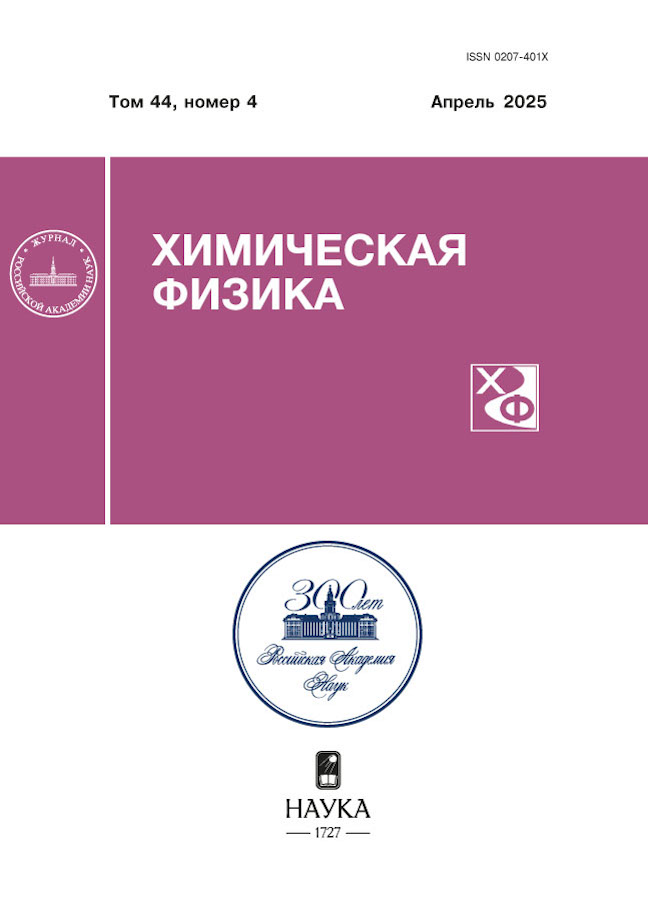Two-dimensional model of combustion of methane-air mixture in a slit burner
- Autores: Belyaev A.A.1, Arutyunov A.V.1,2, Vasilik N.Y.1, Zakharov A.A1, Arutyunov V.S.1,3,4
-
Afiliações:
- Semenov Federal Research Center for Chemical Physics of the Russian Academy of Sciences
- Shenzhen MSU-BIT University
- Federal Research Center for Problems of Chemical Physics and Medical Chemistry, Russian Academy of Sciences
- Gubkin Russian State University of Oil and Gas
- Edição: Volume 44, Nº 4 (2025)
- Páginas: 19-30
- Seção: Combustion, explosion and shock waves
- URL: https://cijournal.ru/0207-401X/article/view/682723
- DOI: https://doi.org/10.31857/S0207401X25040035
- ID: 682723
Citar
Texto integral
Resumo
A two-dimensional model of combustion of a premixed methane-air mixture inside a plane-parallel channel of a slit burner consisting of a set of parallel metal plates made of heat-resistant material is proposed. The task is described by a system of equations representing the laws of conservation of energy in the gas and solid phase, mass and elemental composition of the gas phase, taking into account the course of a complex chemical reaction, heat exchange between the gas and the surface of the plates, radiation from heated plates, thermal conductivity in the plates, molecular and convective heat and mass transfer in the gas. Calculations using the proposed model provide a completely adequate idea of the combustion process in the channel of a slot burner. Quantitative agreement with the experiment was obtained for the maximum value of the specific combustion power, which can exceed 500 W/cm2. In calculations using the proposed model, it is shown that the specific combustion power in the burner device under consideration may exceed 500 W/cm2. As the gas flow velocity (specific combustion power) increases, the chemical reaction zone moves along the channel axis towards the exit. In this case, the flame front with a peak on the axis of symmetry of the channel stretches more strongly along the plate. In a stoichiometric mixture, the flame front shifts closer to the channel entrance, and the concentration of carbon monoxide in the combustion products at the channel exit is significantly higher than in a lean mixture. As the velocity of the gas mixture at the channel entrance increases, the concentration of CO at the channel outlet of the channel grows, although it remains small. The obtained results qualitatively correspond to the experimental results of the study of slit combustion.
Texto integral
Sobre autores
A. Belyaev
Semenov Federal Research Center for Chemical Physics of the Russian Academy of Sciences
Autor responsável pela correspondência
Email: belyaevIHF@yandex.ru
Rússia, Moscow
A. Arutyunov
Semenov Federal Research Center for Chemical Physics of the Russian Academy of Sciences; Shenzhen MSU-BIT University
Email: belyaevIHF@yandex.ru
Rússia, Moscow; Shenzhen, China
N. Vasilik
Semenov Federal Research Center for Chemical Physics of the Russian Academy of Sciences
Email: belyaevIHF@yandex.ru
Rússia, Moscow
A. Zakharov
Semenov Federal Research Center for Chemical Physics of the Russian Academy of Sciences
Email: belyaevIHF@yandex.ru
Rússia, Moscow
V. Arutyunov
Semenov Federal Research Center for Chemical Physics of the Russian Academy of Sciences; Federal Research Center for Problems of Chemical Physics and Medical Chemistry, Russian Academy of Sciences; Gubkin Russian State University of Oil and Gas
Email: belyaevIHF@yandex.ru
Rússia, Moscow; Chernogolovka; Moscow
Bibliografia
- V.M. Shmelev. Combust. Sci. Technol. 2014. V. 186. № 7. P. 943. https://doi.org/10.1080/00102202.2014.890601
- O.N. Bryukhanov, E.V. Kreinin, B.S. Mastryukov. Radiant gas heating. Leningrad: Nedra, 1989 [in Russian]. ISBN:5-247-00516-3.
- M.A. Mujeebu, M.Z. Abdullah, A.A. Mohamad. Energy. 2011. V. 36. № 8. P. 5132. https://doi.org/10.1016/j.energy.2011.06.014
- N.Ya. Vasilik, V.M. Shmelev. Combustion and Explosion (Gorenie I Vzryv (Moskva)), 2019. V. 12. № 1. P. 37. https://doi.org/10.30826/CE19120105
- N. Vasilik, V. Shmelev. Proc. of the Eighth Intl. Conf. on Advances in Civil, Structural and Environmental Engineering – ACSEE 2019, P. 16. ISBN: 978-1-63248-166-5 https://doi.org/10.15224/978-1-63248-166-5-03
- C.L. Hackert, J.L. Ellzey, O.A. Ezekoye. Combust. Flame. 1999. V.116. №.1-2. P.177.
- F.S. Palesskii, S.S. Minaev, R.V. Fursenko, V.K. Baev, A.I. Kirdyashkin, V.M. Orlovskii. Combustion, Explosion, and Shock Waves. 2012. V. 48. № 1. P. 17.
- V.M. Shmelev. Russ. J. Phys. Chem. B. 2020. V. 14. № 6. P. 964. https://doi.org/10.1134/S1990793120060263
- A.A. Belyaev, V.M. Shmelev, N.Ya. Vasilik, A.A. Zakharov, V.S. Arutyunov. Combustion and Explosion (Gorenie I Vzryv (Moskva)). 2020. V. 13. № 2. P.10. https://doi.org/10.30826/CE20130202
- F.A. Williams. Combustion Theory. Addison-Wesley Publishing Co., 1965.
- Burcat. Ideal gas thermodynamic data in polinomial form for combustion and air pollution use. Laboratory for Chemical Kinetics, Institute of Chemistry, ELTE Eotvos Lorand University. Budapest (Hungary). http://garfield.chem.elte.hu/Burcat/burcat.html
- D.A. Frank-Kamenetskiy. Diffusion and heat transfer in chemical kinetics. Moscow: Nauka, 1987 [in Russian].
- R. Reid, J. Prausnitz, T. Sherwood. The properties of gases and liquids. London: McGrow Hill, 3rd ed., 1977.
- V.Ya. Basevich, A.A. Belyaev, V.S. Posvyanskii, S.M. Frolov. Russ. J. Phys. Chem. B. 2013. V. 7. № 2. P. 161. https://doi.org/10.1134/S1990793113020103
- V.N. Mikhalkin, S.I. Sumskoi, A.M. Tereza, K.Y. Troshin, B.A. Khasainov, S.M. Frolov. Russ. J. Phys. Chem. B. 2022. V. 16. № 4. P. 629. https://doi.org/10.1134/S1990793122040261
- A.S. Palankoeva, A.A. Belyaev, V.S. Arutyunov. Russ. J. Phys. Chem. B. 2022. V. 16. № 3. P. 399. https://doi.org/10.1134/S1990793122030204
- S.D. Arsentev, L.A. Tavadyan, M.G. Bryukov, A.S. Palankoeva, A.A. Belyaev, V.S. Arutyunov. Russ. J. Phys. Chem. B. 2022. V. 16. № 6. P. 1019. https://doi.org/10.1134/S1990793122060021
- G. Schlichting. Boundary layer-theory. McGrow Hill, 1979.
- N.Ya. Vasilik, V.M. Shmelev. Combustion and Explosion (Gorenie I Vzryv (Moskva)). 2020. V. 13. № 2. P. 19. https://doi.org/10.30826/CE20130203
- N. Vasilik. Proc. of the 2nd Intern. E-Conference on Advances in Engineering, Technology and Management – ICETM 2020. ISBN: 978-1-63248-189-4. https://doi.org/10.15224/978-1-63248-189-4-07
- N.Ya. Vasilik, A.A. Zakharov. Combustion and Explosion (Gorenie I Vzryv (Moskva)). 2020. V. 13. № 4. P. 29. https://doi.org/10.30826/CE20130404
- N.Ya. Vasilik, S.V. Finyakov. Combustion and Explosion (Gorenie I Vzryv (Moskva)). 2021. V. 14. № 3. P. 27. https://doi.org/10.30826/CE21140304
- Ya.B. Zel’dovich, G.I. Barenblatt, V.B. Librovich, G.M. Makhviladze. The mathematical theory of combustion and explosions. Moscow: Nauka, 1980 [in Russian].
- A.A. Belyaev, B.S. Ermolaev. Russ. J. Phys. Chem. B. 2023. V. 17. № 4. P. 915. https://doi.org/10.1134/S199079312304022X
Arquivos suplementares
















